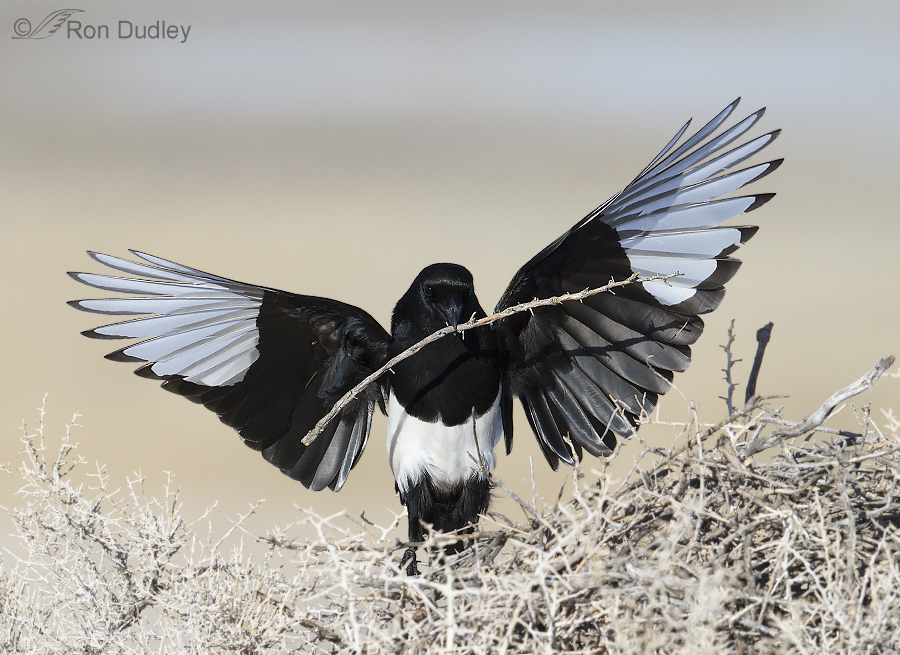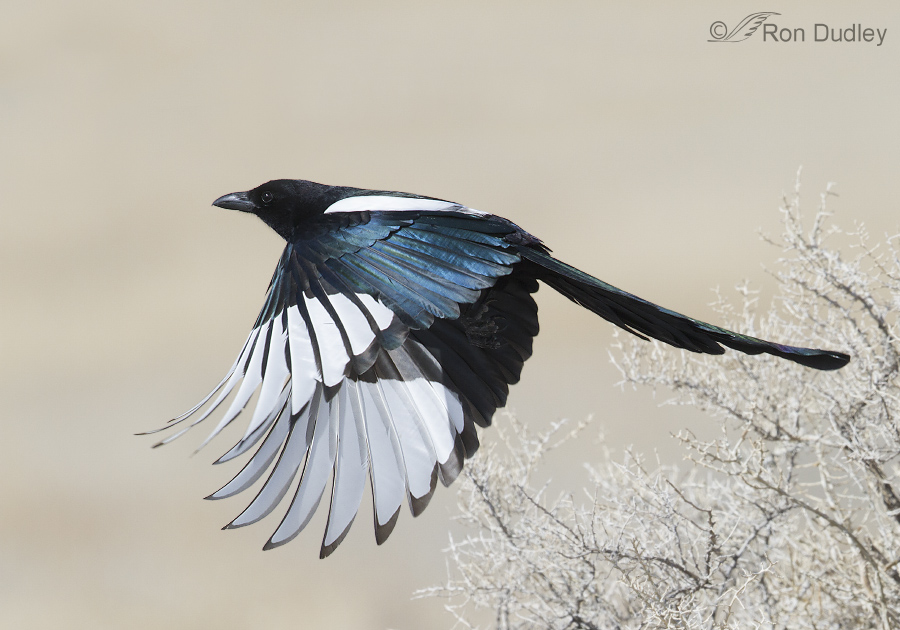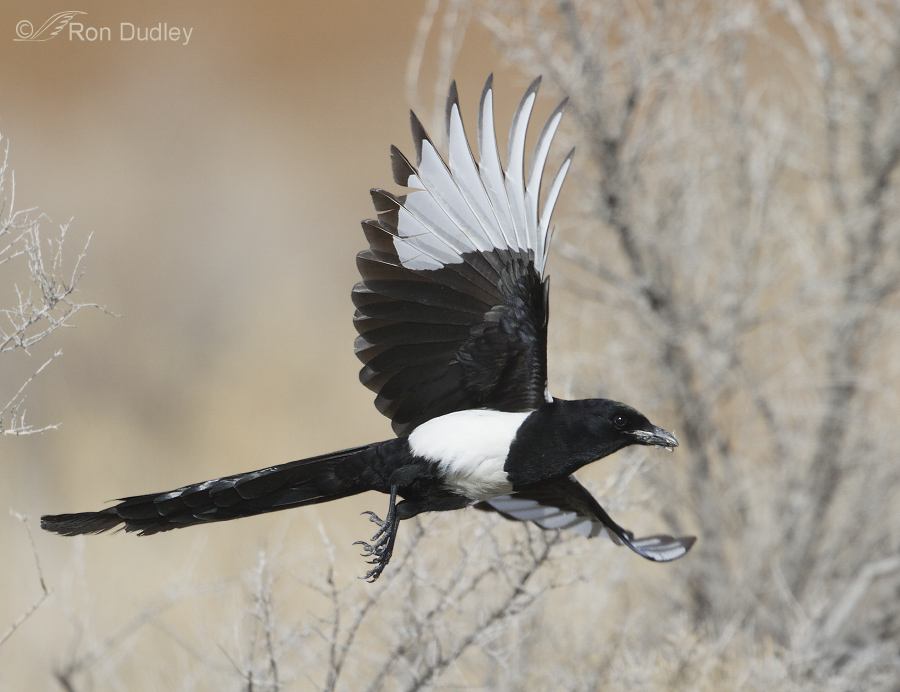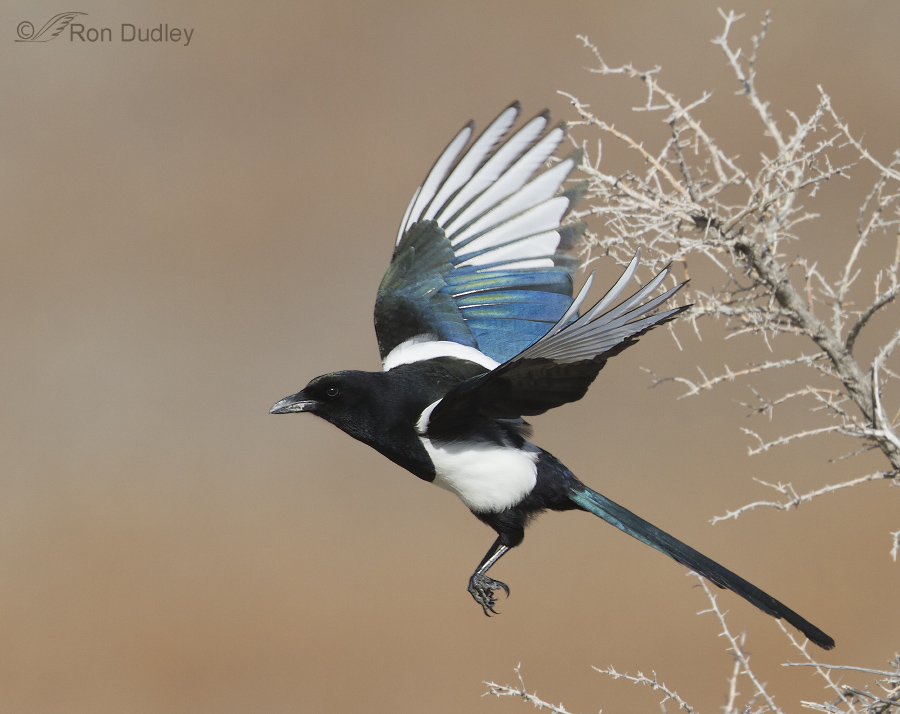Around here Black-billed Magpies are among the first species to begin nest-building activities. It tickles my fancy to see another sign of spring after this miserable winter.
Yesterday I photographed two pairs of magpies as they began to refurbish old nests. They bring twigs to add to the outside of their large, domed nests and more twigs and mud for the interior chamber. I photographed them as they flew back and forth from greasewood to sagebrush to the ground and to the nest. I stayed in my vehicle, on the road or parking lot, and the birds were not disturbed in the least by my presence as I shot them from a comfortable distance.
1/2500, f/7.1, ISO 500, Canon 7D, 500 f/4 II, not baited, set up or called in
This magpie is just landing on one of the greasewoods near the nest with a large twig in its bill. It was a difficult day to get good exposure on these already challenging black and white birds as we had cloud cover early in the morning and by the time the clouds retreated the sun was higher in the sky than I like. There’s not enough room for the “virtual” tail in this composition but you couldn’t see it anyway and I didn’t like the out of focus foreground.
1/2500, f/7.1, ISO 500, Canon 7D, 500 f/4 II, canvas added for composition, not baited, set up or called in
When the light angle is just right you can occasionally catch the spectacular iridescence of the species. Even though this bird took off slightly away from me I still enjoyed the image.
1/4000, f/6.3, ISO 500, Canon 7D, 500 f/4 II, 1.4 tc, not baited, set up or called in
I believe the small item (twig or debris from the interior of last years nest) in the bill of this bird is something the magpie found undesirable and is removing it from the nest. I could be wrong about that though.
1/2500, f/7.1, ISO 500, Canon 7D, 500 f/4 II, 1.4 tc, not baited, set up or called in
You just never know when the iridescence is going to appear. When it does it usually only lasts for a split-second so luck always plays a part, though it helps significantly to maneuver into position with the sun directly behind you if possible.
I’m aware that some folks aren’t magpie fans but I really enjoy their antics, behaviors and the range of their calls. These birds will spend several weeks refurbishing their nests before laying eggs and I look forward to more time with them, though next time I hope it’s earlier in the morning.
Ron






This is a really nice set of photos. I like the second one best. I’ve been a few places where I’ve seen magpies, but have never lived near them so I’ve never developed a prejudice against them. A good thing.
The size of a Magpie nest reminds me of the huge nests monk parakeets make, only they tend to have multiple tenants…not all of which are parakeets!..and that monk parakeets build their nests in trees, not on the ground. Where is the entrance and in what part of the nest do the magpies live? Near the center? Near the top? How far down from the top? On higher ground, if possible? Near water? It’s interesting that, like eagles, they “renovate” each year,adding new material to the old, previously used, making it bigger and bigger. I know Eagles’ nest can actually collapse or break off the supporting branches when they finally get too big and heavy….Magpies are like B’rer Rabbit in the briar patch…
Gorgeous shots Ron!
Charlotte
Ron
The iridescence you caught is spectacular.
The reminder from Ed to share the beauty we see made me remember how much you so generously share. And thanks to Dan for teaching me the difference in types of imprinting.
Thanks, Diana. Agreed – Dan’s comment was very helpful.
I am endlessly fascinated by magpies. Ours don’t have the iridescence of yours – and have a much more feisty nature, but I love them. And yours.
Ours can be fairly feisty too, Elephant’s Child but from what you’ve said in the past yours have ours beat by a long shot.
Love those magpies. We had below-zero weather most of last week here in Helena. Their flitting was as interesting as always, but when they perched they really fluffed up. Appreciate your daily reminders that we are in a world we need to share and, in particular, share all the beauty we can.
Well said, Ed. Thank you.
They are beautiful! Especially in flight, as you’ve captured them so nicely.
Thank you, Christina.
I love these photos! Although magpies can be such a pain sometimes, I really enjoy watching them. A couple years ago I met a man from back east somewhere who was here in Teton Valley to ski at Grand Targhee. He asked me what those beautiful, big, black and white birds were that he’d been seeing all over. I had to laugh when I realized he was talking about the magpies and felt bad to tell him they were our trash birds. But I have to agree, they really are beautiful birds. And with such great personalities!
Marya, Most folks in the east and south never see magpies so they can seem quite exotic. I agree that they’re beautiful and they’re also smart and resourceful. I think they’re admirable in most ways but will admit they annoyed me one year when they nested in one of my yard trees. Oh the racket they can make when they have chicks and there are cats around (not mine). They made up for the annoyance though when they entertained me be sneaking up behind the cat and pulling its tail. Multiple times. Seldom have I had so much fun!
I can only imagine! I’m laughing just thinking about it! I don’t suppose you have pictures of the magpies and the cat?
Nope, I don’t Marya. I was working in the garden, dirty and muddy, and couldn’t go into the house for a camera. Besides, I was afraid I’d miss some of the fun..
Ron–Thank you for making it possible to see these amazing images of a bird that has become, thanks to you, one of my top favorites. Whether or not you’ve captured their iridescence, I find them incredibly beautiful and elegant. I enjoy seeing them as many times as possible and would have been very sad to have missed on these…the first and second are particularly lovely and I’m so glad I can view them., I love the angle of the body, the feet position and the the composition (perfect!) in the third frame. When I look at the shaggy tangle they have to penetrate in order to access their nests, I worry about their eyes.. Nest building for these guys looks dangerous!
You’ve got that right, Patty – that “shaggy tangle” is complicated to penetrate. There are two entrances (I can usually only see one and just barely) which weave through the tangled twigs and I’m amazed they can get in there, especially when they’re carrying a new twig to line the interior. Interesting that they instinctively know (or maybe it’s intelligence, after all they ARE a corvid) that only smaller twigs can be maneuvered inside, bigger ones go on the outside of the nest.
I’ve been trying to capture that “iridescent moment” with Grackles and Red-winged Blackbirds and I understand about the timing! That, and the challenge of proper exposure of all that black/dark color. I can’t imagine how you balanced the black AND white of a Magpie so magnificently! (Well, yes, I can – you happen to be GOOD!)
All of the great photography and wonderful behavioral images, too. Mighty good stuff, Ron!
I appreciate the kind words Wally but I must admit that I sure took a lot of shots to get a few good ones – over 400 of them just of magpies yesterday and I’ll probably keep about 20.
Spectacular photos, as always. Thanks for sharing your skills.
About imprinting…There two kinds of imprinting. The first is what we are most familiar with and occurs most strongly in precocial birds, like waterfowl and sandpipers that leave the nest very soon after hatching. For chicks of these birds it is critial that they imprint on a parent immediately. In this way, they know who to follow so that they can find food and be defended. This kind if imprinting is less important for birds that will remain in the nest until fledging. The nest provides shelter and defense and the parents provide food. There is a second kind of imprintiing which occurs at a point near fledging. At this time, it is important to define who you are and who you will associate with the rest of your life. If humans are your only contact, then you will want to associate with them and will often avoid your own species, including not wanting them for mates. Such birds are doomed to an abnormal existence and in the wild, may noy survive long as adults without human care. However, we need to be careful about interpreting behavior. I have Townsend’s Warblers that will feed from my fingers and Pine Siskins have done the same thing. These are wild birds and NOT imprints. Both of these species are generally less fearful of humans than are most birds and if approached with care, will tolerate you being near them..
Fascinating stuff, Dan – thank you. I’ve studied the imprinting work of Konrad Lorenz but as I remember his work was largely on (precocial) geese.
Interesting, Dan. Thank you.
We did not feed him, but did keep an eye on the little guy while he was on the patio as he seemed vulnerable. His siblings, of which there were two others, remained in the nest above until a few days later when they all began to fly. His parents happily surprised us when they came down and fed him when he was on the patio; but my husband did talk to the little guy and it’s as if he knows and remembers him.
Since we have heard that putting feeders out (besides seeming a bit unnatural and unnecessary here)may attract things which attract rattlers, we’ve never put feeders of any kind out. Evidently our soil/ground has LOTS of stuff they love, as they are often scratching and pecking. They visit the waterfall constantly, and love all the trees and bushes. Lots of my plants attract the hummingbirds, which also like to drink from the waterfalls. Just love having all of them around, and am trying to learn more about them – so love Ron’s posts!
Hey, Dan, my good friend! Glad you chimed in here. I would just appreciate some clarification on a subject which is NOT all that clear to start with! When you say ‘closer to fledging’ for altricial birds, I’ve always said ‘as their eyes open and focus.’ Obviously, some birds hatch with eyes open (e.g., falcons) and some take days before their eyes open (e.g., owls) but imprinting is pretty visually oriented. Yes, they hear and recognize calls, even in the egg, and I’ve had a blind fledgling saw-whet that would recognize parent-coming-home-with-food calls but not saw-whet alarm calls; and some song birds like white-throated sparrows need to hear male songs in order to be able to reproduce them … but imprinting has always, in my mind, functioned around vision: a search image for appropriate food, natal territory, siblings and parents. Maybe for most songbirds who only spend a couple of weeks in the nest, it’s ‘before fledging’ – but for birds like owls, who ‘branch’ and leave the nest before they actually fledge… it seemed more accurate to say it was for a week or so after the eyes opened. What think you?
Just beautiful! We are also seeing nest building activity in the birdhouse in one of our rock gardens near the patio. We are pretty sure one of the babies from a couple years ago which my husband rescued when he was kicked from a nest (built in our patio roof rafters), has become a regular visitor. He comes right up to my husband and seems to talk to him. All animals love my husband – even the lizards will follow him around the yard – but this particular bird which I think is a sparrow – seems to really like and “hang out” with him when he’s outside. Is this possible? As you know, I have very little knowledge of birds, but am fascinated by them and their activity. – Thanks, as always for sharing these beautiful photos and text.
Sure, I’d say it’s possible, Patricia. Could the bird have imprinted on your husband when he rescued it?
Quite possibly. It’s as if the two bonded. When he first began to attempt flying, he flew to our patio chair just outside our back window. A few days later, he flew and “fluttered” in the front window, and often perches himself on the split-rail fence outside my office window. But when my husband is home and working outside, even sawing and making noise, the little fellow comes around and talks with him.
This morning there are quite a few different birds happily chirping outside my window this morning as if announcing the approach of spring. Just love it! Only the Mourning Dove’s monotonous call sometimes annoys me.